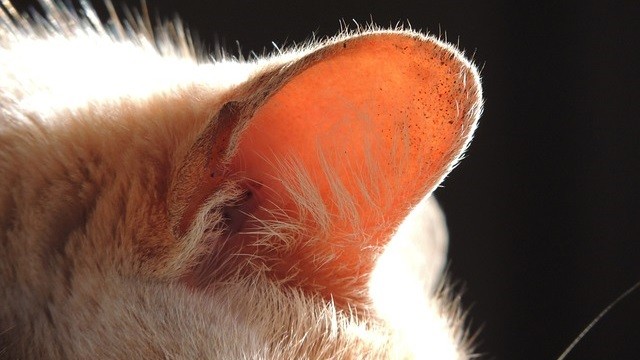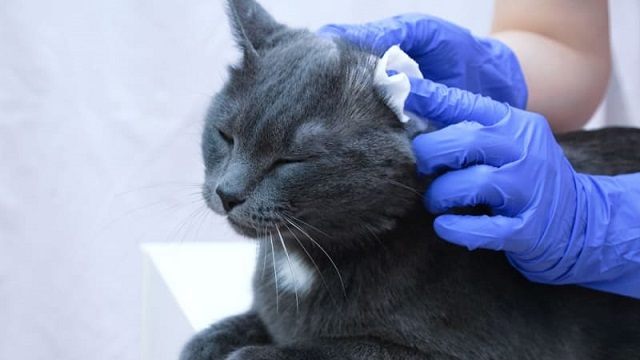A cat ear infection can be a painful problem for felines, causing discomfort and even hearing loss if untreated. Let’s take a look at the symptoms, causes, and treatments of cat ear infections to help you keep your feline friend healthy and happy.
What Are Cat Ear Infections And How Are They Caused?

Cat ear infections are also known as otitis. They occur when microorganisms like bacteria, fungi, or ear mites invade the ear canal and cause inflammation, irritation, and discomfort.
Ear infections can be caused by various factors, including ear mites, allergies, bacteria, fungi, excessive moisture, and foreign objects:
- Ear mites are tiny parasites that live in the ear canal and feed on ear wax and oils. Their presence can cause irritation and inflammation, leading to an infection.
- Cats can develop allergies to certain foods, pollen, dust, or other environmental factors that can trigger inflammation and irritation in the ears.
- Bacteria or fungi can enter the ear canal through cuts or scratches in the skin, causing infections.
- Excessive moisture in the ears can create a damp environment that promotes bacterial and fungal growth.
- Foreign objects, like grass seeds or debris, can also get lodged in a cat’s ear and cause irritation and infections.

Is Maven right for your pet?
Take the quiz and see how Maven can support your pet’s wellness journey.
Breeds of cats with folded or hairy ears, such as Persian and Scottish Fold cats, may be more prone to developing ear infections due to the unique shape of their ears, which can trap moisture and debris. Additionally, cats with weakened immune systems or chronic medical conditions like diabetes may also be more susceptible to ear infections.
Signs And Symptoms Of Cat Ear Infections

Cats with ear infections may display a range of signs and symptoms:
- Cats with ear infections may scratch or rub their ears frequently to relieve itchiness or discomfort.
- An ear infection may cause your cat to shake their head vigorously or tilt their head to one side.
- Ear infections can cause a smelly discharge within the ear canal. The discharge may be black, brown, or yellow in color and have a foul odor.
- The ear canal may appear red and swollen.
- Cats with ear infections may become more sensitive to touch, especially around the ears.
- In severe cases, an ear infection can affect a cat’s balance and coordination.

Maven Pet
Health Monitor
#1 Vet-recommended pet monitor! Tracks activity, rest, respiratory rate, water intake, scratching and other health indicators 24/7
How Are Cat Ear Infections Diagnosed?
If you suspect your cat has an ear infection, your veterinarian will examine your cat’s ears and take a sample of the ear discharge to identify the underlying cause of the infection. To this end, they may use an otoscope, a specialized instrument with a light and magnifying lens, to examine the ear canal and look for signs of inflammation, swelling, or foreign objects.
In some cases, additional diagnostic tests may be necessary. These help identify the specific microorganisms causing the infection and determine the most effective treatment plan. They may involve taking a sample of the ear discharge or performing a skin biopsy to analyze the skin cells for signs of infection or inflammation.
Early diagnosis and prompt treatment are crucial in managing cat ear infections and preventing more severe complications. If you suspect your cat has an ear infection, it’s important to seek veterinary care promptly to ensure proper diagnosis and treatment.
How Are Cat Ear Infections Treated?

In many cases, treatment of cat ear infections can involve a combination of medication, cleaning, and management of any underlying conditions.
Medication may include antibiotics or antifungal drugs to eliminate the microorganisms causing the infection. These can either be given orally or applied directly to the ear. Ear mite infestations can be treated with medications that kill the mites and prevent their spread.
Cleaning the ears is an essential part of treating ear infections in cats. Your veterinarian may recommend a specific ear cleaner to remove any debris, wax, or discharge from the ear canal. It’s important to follow your veterinarian’s instructions on how to clean your cat’s ears safely and effectively.
In some cases, managing underlying conditions like allergies or immune system disorders may also be necessary to prevent recurrent ear infections.
Preventing Cat Ear Infections: Tips and Best Practices

While some cats may be more prone to ear infections than others, there are several things you can do to help prevent these infections from occurring.
Regular ear cleaning can help remove excess wax and debris from your cat’s ears and reduce the risk of infection. Use a veterinary-approved ear cleaner and follow your veterinarian’s instructions on how to clean your cat’s ears safely.
Never use cotton swabs or other sharp objects in your cat’s ears. They can damage the ear canal and increase the risk of infection.
Excess moisture in the ear canal can promote the growth of bacteria and fungi. So avoid exposing your cat to wet environments for prolonged periods and dry your cat’s ears thoroughly after bathing.
If you notice any unusual or concerning symptoms, or need help deciding if your cat has an ear problem, ask your vet!
Maven Pet focuses on improving the quality of life of our pets with technology, using artificial intelligence (AI) to enable proactive pet care. By accurately collecting and monitoring pet data 24/7 and flagging any irregularities, Maven Pet empowers pet parents and veterinarians to stay ahead of potential health issues, ensuring the well-being and longevity of our beloved companions.



